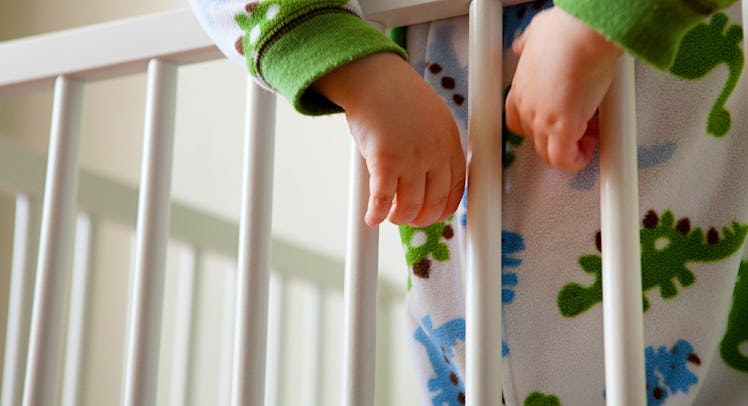Baby Crib Buyer’s Guide: 9 Things to Look for When Buying a Crib
From the mattress to the wheels, here's what to look for in a sturdy, strong, and safe crib.

Your baby’s going to spend a huge chunk of the first two to three years of their life in a crib, so make sure you see it as an investment — meaning getting one that is built to last and the safest crib possible. All baby cribs manufactured after 2011 are required to meet U.S. Consumer Product Safety Commission standard; one of those requirements is that the date of manufacture needs to be printed somewhere on the crib so you can check.
RELATED: Signs Your Kid Has a Sleep Disorder
“Parents shouldn’t use any cribs manufactured before that date,” says Joyce Davis, president of sleep safety nonprofit Keeping Babies Safe. In fact, she says, “It’s illegal to manufacture or sell any crib that doesn’t meet the new crib safety standards.”
Also important is to check for crib recalls at and the Keeping Babies Safe website before buying one, as baby products are recalled for safety issues pretty frequently.
Some parents who live in small apartments might be drawn toward a mini crib, which (obviously) takes up less space than a full-size crib. It’s a bit of a crapshoot, because some babies might grow out of mini cribs before they’re ready to transition to a toddler bed, so parents might end up shelling out for a bigger crib later. But in terms of safety, portable or mini cribs are fine as long as they meet the current safety standards, Davis says.
The important thing is that the mattress is the right size for the crib, because you don’t want space between the pad and edges of the crib. “Never use a supplemental mattress or added mattress to a mesh-sided play yard,” Davis adds. “And only use the mattress or pad that comes with the crib, bassinet, or play yard.”
To keep crib time safe, remember the “bare is best” rule: no soft bedding, no crib bumpers, pillows, blankets, comforters, or toys, she says. And keep the crib away from windows, curtains, and any chords that the baby could use to pull him or herself out of the crib or could pose strangulation hazards.
Things To Look For In A Baby Crib
Here are a few specific things parents should look for in a safe crib:
- Crib slats or bars should be no wider than 2 3/8 inches apart. Some experts suggest gauging whether a soda can would fit through — if so, they’re dangerously far apart.
- Mattresses should be dense, firm, and not sag under your baby’s weight. They also need to reach every corner of the crib, with no spaces around the sides.
- Look for a crib with an adjustable mattress. The top of the crib’s rail should be 26 inches above the mattress; you’ll need to lower the mattress periodically as your child grows.
- Headboards should be solid with no decorative cutouts, and also make sure the corners don’t have pointy embellishments on them that kids’ clothing could get caught on.
- Cribs with a drop-side no longer meet safety requirements (so you should say no if someone tries to give you one).
- Don’t bother with bumpers in the crib; there’s no evidence that they make kids safer and older kids might use them to help them climb out of the crib.
- Make sure the crib doesn’t wobble when you shake it but feels sturdy. If it shakes it might have been put together improperly.
- Look for any screws, nails, or glue that stick out anywhere on the crib. And if it’s painted, the paint shouldn’t be peeling or splintery.
- If the crib is on wheels, make sure they lock, particularly if the crib will be on a wood or tile floor.